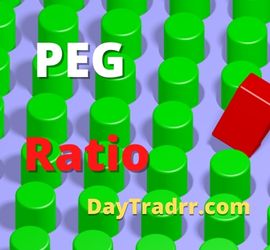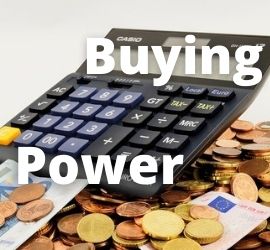PEG Ratio – What Is the Price/Earnings-to-Growth?
 The PEG ratio is a metric that assists in determining the value of a stock by comparing market price, earnings, and future growth potential. The PEG ratio is the price/earnings to growth ratio. It is a stock’s price-to-earnings (P/E) ratio divided by the earnings growth rate over a given time period. The PEG ratio is used to estimate the value of the stock while also considering the company’s predicted profit growth. It is regarded to provide a more complete picture than the more common P/E ratio.
The PEG ratio is a metric that assists in determining the value of a stock by comparing market price, earnings, and future growth potential. The PEG ratio is the price/earnings to growth ratio. It is a stock’s price-to-earnings (P/E) ratio divided by the earnings growth rate over a given time period. The PEG ratio is used to estimate the value of the stock while also considering the company’s predicted profit growth. It is regarded to provide a more complete picture than the more common P/E ratio.
Many investors examine a company’s price-to-earnings ratio (P/E ratio) to decide if it is a suitable investment. However, P/E alone may conceal that the stock is overpriced or underpriced without considering future earnings growth. The price-to-earnings ratio of a corporation is simply the stock price divided by earnings per share. For example, consider two companies that have the same price-to-earnings ratio. But, one has experienced a 40% increase in earnings over the last three years. The other has only experienced a 10% increase in earnings. Therefore, the stock that is growing faster is likely underpriced and may be a better company to invest in.
How to Calculate the PEG Ratio
PEG Ratio = (Price / EPS) / EPS Growth
To compute the PEG ratio, an investor or analyst must first look up or calculate the company’s P/E ratio. The P/E ratio is derived by dividing the company’s share price by earnings per share (EPS). After calculating the P/E, determine the predicted growth rate for the stock in question. You can conveniently do this using analyst forecasts available on financial websites that track the stock.
Accuracy
The accuracy of the PEG ratio, like that of any other ratio, is determined by the inputs utilized. It can be convenient to analyze a company’s PEG ratio from a published source. However, it’s critical to verify the growth rate employed in the computation. Using historical growth rates, for example, may result in an erroneous PEG ratio. Growth rates can change over time. Double-check if future growth rates are likely to diverge from a company’s prior growth. For example, the ratio can be calculated using one-year, three-year, or five-year predicted growth rates. The terms “ahead PEG” and “trailing PEG” are occasionally used to distinguish between calculation methods. The difference is when using future growth versus those that might use historical growth.
What Is a Good PEG Ratio?
A PEG ratio of 1.0 or lower, on average, indicates that a company is properly priced or even undervalued. A PEG ratio greater than 1.0 indicates that a stock is considered expensive. PEG investors seek equities with a P/E ratio equal to or less than the company’s predicted growth rate. Investors should, of course, not rely solely on the PEG ratio or any other single financial metric. A ratio of less than or greater than 1.0 in and of itself does not indicate a good or terrible investment.
The PEG ratio can be useful in evaluating similar companies based on their respective growth rates. However, there are predictions that go into the PEG Ratio and the uncertainty surrounding any company’s future growth. The PEG ratio is a tool. Nevertheless, it should be used as only one of several criteria in analyzing any investment.
PEG Ratio – Why It Matters
The PEG ratio indicates how pricey a company is in comparison to its growth rate. However, the price-to-earnings ratio is the most widely used statistic among investors. But, it has a significant benefit over the P/E ratio in that it adjusts it for growth. Higher P/E ratios are typically associated with faster growth rates. But, the PEG allows investors to evaluate businesses with high and low P/E ratios based on their growth rates. The PEG also allows investors to quickly determine how inexpensive a stock is in relation to its growth rate. When all else is equal, a lower ratio is preferable.
A low P/E ratio may make a stock appear to be a good investment. However, the PEG ratio takes into account the company’s growth rate and may paint a different picture. The lower the PEG ratio, the more likely the company is undervalued in relation to its future profit estimates. Including a company’s predicted growth rate in the ratio helps to level the playing field. For example, it can adjust the outcome for companies with a strong growth rate and a high P/E ratio. The extent to which a result implies an overpriced or underpriced stock differs by industry and company type. Some investors believe that a PEG ratio less than one is preferable as a general rule.
PEG Vs P/E
- The Price to Earnings ratio – of a company is calculated by taking a stock’s price per share and dividing it by its annual earnings per share. This is done to determine what the ratio is between a company’s annual earnings and its stock price. For example, if a stock earns $10 per share and has a stock price of $200 per share then the company’s P/E ratio is 20. That means that its share price is 20x its earnings.
- A PEG ratio – is calculated by taking that P/E ratio and then dividing it by a company’s growth rate over a specific period of time. For example, if the stock mentioned above grew 20% in the last year, its PEG ratio would be 1.0.
Both metrics provide information to investors about a company. However, the PEG ratio incorporates information that Price to Earnings does not provide. As a result, the former gives an investor a clearer picture of a firm’s value in relation to its share price.
PEG Ratio – Example
If you’re deciding between two stocks from the same industry, considering their growth potential could shed light on the decision. For example, NextBigThing Inc. stock may trade at 20 times earnings, whereas YesterdaysBigThing Corp stock may trade at 22 times earnings. If you only consider the P/E ratio, NextBigThing may appear to be a better bargain and more enticing alternative.
However, NextBigThing has a projected five-year earnings growth rate of 15% per year. Conversely, YesterdaysBigThing earnings have a projected growth rate of 24% per year for the same period. Here’s what the calculations reveal:
When you take expected growth into account, YeaterdaysBigThing could be the better choice. This is because it’s actually trading for a discount compared to its value. Many investors may prefer NextBigThing Inc. since it has a lower P/E ratio (20 vs 22). However, in comparison to YesterdaysBigThing, it does not have a high enough growth rate to support its P/E ratio. YesterdaysBigThing is trading at a discount to its growth rate, so buyers pay less per unit of profit growth.
PEG Ratio For Investors
PEG ratios can help you determine if a firm is overvalued, underpriced, or suitably priced in relation to its anticipated earnings. The PEG ratio of a stock can also be used to compare it to other firms in the same industry. Many investors use the P/E ratio to compare a stock’s performance to that of its competitors. However, this is a troublesome indicator to employ when two firms are at different stages of their lifecycle. Or, if one is expanding considerably faster. The PEG ratio considers different companies’ growth rates. This lets investors better comprehend a stock’s pricing in relation to its potential for future growth. Also, it assists investors in identifying stocks that are expected to appreciate in value in the future.
A PEG ratio is a valuable indicator that investors may use to better assess the value of a firm. It is especially beneficial when comparing growing firms with established organizations. This is because it helps to further evaluate the relative value of their stock prices considering growth potential.
Up Next: What Is a Forward Contract?
 A forward contract is a tailored agreement between two parties to acquire or sell an item at a predetermined price on a future date. Forward contracts can be used for hedging or speculating, although due to their non-standardized character, they are best suited for hedging.
A forward contract is a tailored agreement between two parties to acquire or sell an item at a predetermined price on a future date. Forward contracts can be used for hedging or speculating, although due to their non-standardized character, they are best suited for hedging.
A forward contract, also known simply as a forward, is a binding commercial agreement. The forward contract is a sort of derivative. This is because its value is derived from the underlying asset that will be delivered on the specified date. To reduce price fluctuation, forward contracts can be utilized to lock in a set future price. The buyer of a forward contract takes a long position. Conversely, the seller of a forward contract takes a short position. If the underlying asset’s price rises, the long position benefits. The short position gains if the underlying asset price falls. While similar, forward contracts are not quite the same as futures contracts. There are subtle differences, so the two terms should not be used interchangeably.




